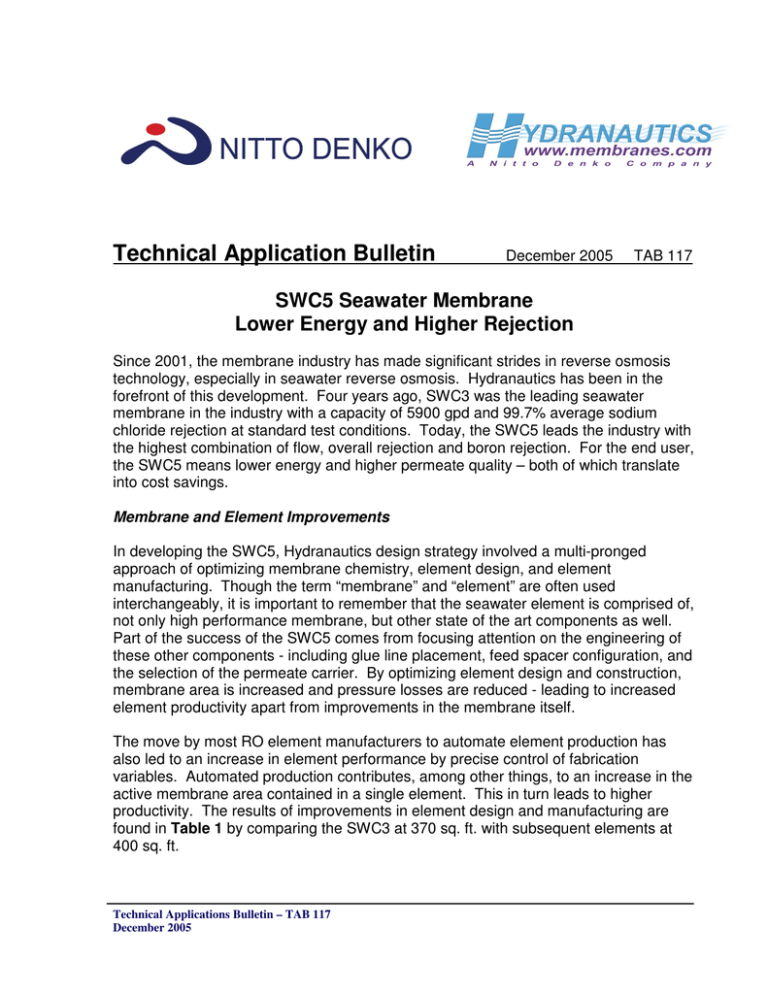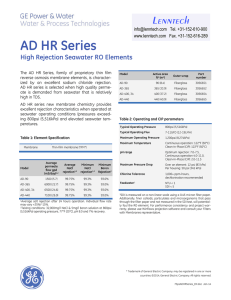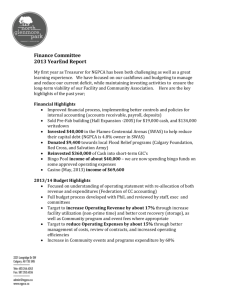Technical Application Bulletin SWC5 Lower Energy and Higher Rejection
advertisement

Technical Application Bulletin December 2005 TAB 117 SWC5 Seawater Membrane Lower Energy and Higher Rejection Since 2001, the membrane industry has made significant strides in reverse osmosis technology, especially in seawater reverse osmosis. Hydranautics has been in the forefront of this development. Four years ago, SWC3 was the leading seawater membrane in the industry with a capacity of 5900 gpd and 99.7% average sodium chloride rejection at standard test conditions. Today, the SWC5 leads the industry with the highest combination of flow, overall rejection and boron rejection. For the end user, the SWC5 means lower energy and higher permeate quality – both of which translate into cost savings. Membrane and Element Improvements In developing the SWC5, Hydranautics design strategy involved a multi-pronged approach of optimizing membrane chemistry, element design, and element manufacturing. Though the term “membrane” and “element” are often used interchangeably, it is important to remember that the seawater element is comprised of, not only high performance membrane, but other state of the art components as well. Part of the success of the SWC5 comes from focusing attention on the engineering of these other components - including glue line placement, feed spacer configuration, and the selection of the permeate carrier. By optimizing element design and construction, membrane area is increased and pressure losses are reduced - leading to increased element productivity apart from improvements in the membrane itself. The move by most RO element manufacturers to automate element production has also led to an increase in element performance by precise control of fabrication variables. Automated production contributes, among other things, to an increase in the active membrane area contained in a single element. This in turn leads to higher productivity. The results of improvements in element design and manufacturing are found in Table 1 by comparing the SWC3 at 370 sq. ft. with subsequent elements at 400 sq. ft. Technical Applications Bulletin – TAB 117 December 2005 Table 1. Evolution of the Hydranautics SWC element. Performance is based on testing at standard test conditions of 3.2% NaCl, 800 psi, 10% rec, and temperature of 25 C. Flow Area Area Flow Rej 2 3 Product Year (m ) (m /d) (sqft) (gpd) (%) SWC3 370 34.4 5900 22.3 99.7 2001 SWC3+ 400 37.2 7000 26.5 99.8 2003 SWC5 400 37.2 8000 30.3 99.8 2004 SWC5 400 37.2 9000 34.1 99.8 2005 Coupled with the improvements in element engineering and manufacturing are advancements in the existing polyamide membrane chemistry which result in higher permeability and therefore lower pressures. But lower pressures are not the only parameter that reduces the cost of desalination. Along with lower pressures is the need to maintain high permeate quality. That is why a guiding strategy in Hydranautics research and development is the idea that an increase in membrane permeability should not necessarily result in a loss of membrane rejection. To produce a high flow element with a lower rejection requires a modification of existing technology and should not be considered a “breakthrough”. The result of Hydranautics concerted strategy to improve both flow and rejection is the SWC5 at 9000 gpd and 99.8% NaCl rejection. Performance Comparison As part of Hydranautics strategy to gage and maintain its position as the seawater RO technology leader, the published, projected, and actual performance of seawater RO membranes offered by other membrane manufacturers is continuously monitored. Figure 1 below compares the published flows and NaCl rejection of seawater elements from two competitors and Hydranautics – including the SWC5. The high flow, energy saving membranes from other membrane manufacturers, Membranes A3 and B3, both produce flows comparable to that of SWC5’s 9000 gpd, but both membranes do so at 99.7% rejection which translates into a salt passage 50% higher than that of the SWC5. This difference in salt passage can have significant cost implications for large desalination plants. In the past several years, boron rejection has become an important factor in seawater desalination due to its adverse effects on agriculture at concentrations as low as 1 mg/L. Additionally, because the human health effects of boron are not yet fully understood, the World Health Organization (WHO) has recommended a maximum concentration of 0.5 mg/L. Fortunately, the high salt rejection of the SWC5 translates into high boron rejection as well. At 92% boron rejection, the SWC5 has the highest combination of boron rejection and energy savings available. To demonstrate the high boron rejection of SWC5, Hydranautics tested several membranes from two other manufactures-including Mem A3, an energy saving membrane with specifications Technical Applications Bulletin – TAB 117 December 2005 similar to those of the SWC5. Figure 2 below shows the results of actual element testing in which the SWC5 tested greater than 92% rejection while Mem A3 tested at 90% boron rejection. Published SeaWater Element Performance (3.2% NaCl, 800 psi, 25 C) 100 99.9 99 98 SWC3+ SWC5 99.8 Mem B1 Mem B2 Mem A2 99.7 Mem B3 Mem A3 Mem A1 Boron Rejection (%) SWC4+ NaCl Rejection (%) Seawater Element Comparison (3.2% NaCl + 5 ppm B, 800 psi, 10% rec, pH = 7) 97 96 95 94 SWC5 SWC4+ 93 92 Mem A1 SWC3+ 91 90 99.6 5,000 6,000 7,000 8,000 9,000 10,000 Permeate Flow (gpd) Figure 1. Published flow and NaCl rejection of Hydranautics and competitor’s seawater elements tested at standard test conditions. Mem B2 89 5,500 Mem A2 6,500 7,500 Mem A3 8,500 9,500 Permeate Flow (gpd) Figure 2. Actual flow and boron rejection of Hydranautics and competitor’s seawater elements tested at standard test conditions of 3.2% NaCl + 5 ppm B, 800 psi, 10% rec, and pH = 7. To more clearly contrast the combined high flow and high rejection of the SWC5 with other energy saving membranes, Figure 3 below plots the water transport coefficient and salt transport coefficient of each membrane. The coefficients proved a more accurate view of the membrane performance by decoupling the flow and salt passage and allowing them to be considered independently of one another. The three membrane manufacturers have all developed an energy saving membrane as illustrated by the sharp increase in water transport. SWC5, Mem A3, and Mem B3 all have similar high permeability. But a notable difference arises when focusing on the increase in salt transport of each energy saving membrane. A sharp increase in salt transport accompanies the increase in permeability for Mem A3 and B3 leading to a salt transport coefficient that is 50% to 66% higher than the SWC5. The SWC5 achieves high permeability without sacrificing permeate quality. Technical Applications Bulletin – TAB 117 December 2005 Comparison of Seawater Membrane Permeability and Salt Transport 5.0E-06 Energy Saving Membranes 4.5E-06 3.5E-05 4.0E-06 3.0E-05 3.5E-06 2.5E-05 3.0E-06 2.0E-05 2.5E-06 1.5E-05 2.0E-06 1.0E-05 5.0E-06 Water Transport Salt Transport 1.5E-06 em B 1 M em B 2 M em B 3 1.0E-06 M A em 1 M A2 em A 3 em M M SW C SW 3 C 3 SW + C 4+ SW C 5 0.0E+00 (cm / sec) Membrane Permeability (ml/(cm2 * sec * atm)) 4.0E-05 Membrane Salt Transport 4.5E-05 Product Figure 3. Comparison of Energy Saving Membranes water transport and salt transport with other membranes produced by the various manufactures. SWC5 achieves a high water transport while maintaining low salt transport. In addition to published data and standard tests done with sodium chloride feed at the manufacturing facility, Hydranautics conducted field tests of the SWC5 on Pacific seawater feed. The single element pilot ran at an average flux of 10 gfd and 12% recovery. The feed contained 30,400 mg/L TDS and 4.2 mg/L of boron. Figures 4 & 5 below show feed pressures, overall rejection based on conductivity, and boron rejection of the SWC5 and other seawater membranes. The data confirms the superior performance of SWC5 relative to other energy saving seawater membranes. In this test, SWC5 operated at the lowest pressures of all membranes tested while achieving comparable or superior rejection to that of the competing energy saving membrane, Mem A3. Technical Applications Bulletin – TAB 117 December 2005 SWC5 Field Test SWC5 Field Test SWC3+ 99.7 SWC5 99.6 Mem A3 Mem B2 99.5 Mem A2 99.4 3.6 3.8 4 4.2 4.4 Pressure (Mpa) Figure 4. Feed pressure and rejection based on conductivity for SWC5 and comparable high flow and high rejection seawater RO membranes at 10 gfd, 12% recovery, and 30,400 mg/L TDS. Rejection (%) Rejection (%) 99.8 85 84 83 82 81 80 79 78 77 76 75 SWC3+ SWC5 Mem A3 Mem B2 Mem A2 3.6 3.8 4 4.2 4.4 Pressure (Mpa) Figure 5. Feed pressure and boron rejection for SWC5 and comparable high flow and high rejection seawater RO membranes at 10 gfd, 12% recovery, and 30,400 mg/L TDS and 4.2 mg/L boron. Cost Savings Cost savings is the clear implications of SWC5 performance for seawater desalination. Up to 80% of a desalination plant’s power usage comes from the high pressure feed pumps of the first pass. Compared to seawater membrane technology from five years ago, the use of SWC5 could reduce the first pass pumping power by 0.21 kWh/m3 and reduce the overall water cost by more than 35% Not to be overlooked is the operational and capital cost savings derived from a high rejection membrane producing a low salinity permeate. To meet final product water requirements, seawater desalination plants typically require a second pass brackish RO system to treat a portion of the permeate coming from the first pass. A full second pass can add as much as 20% to the overall water cost of the plant. Relative to a 99.7% rejection seawater membrane, the low salinity permeate coming from a SWC5 first pass would require less processing and therefore a smaller second pass to deliver the same capacity with the same quality. As an example, consider a 47,000 m3./d plant operating on a 40,000 mg/L seawater at 50% recovery in the first pass and 90% recovery in the second pass. If the overall product water quality requirement is less than 300 mg/L, only 5% of the SWC5 product would require processing by a second pass. However, if the SWC5s were replaced with 99.7% rejection membranes, the amount of permeate to be processed would increase to 35%. The first pass capacity would increase by 3.6% and the second pass capacity would increase nine times. Technical Applications Bulletin – TAB 117 December 2005 Conclusions When comparing both permeability and salt rejection, the SWC5 outperforms competing energy saving membranes. Published performance and actual test data done at Hydranautics and in the field demonstrate the similar permeability and superior salt rejection of SWC5 relative to other energy saving membranes. • The success of the SWC5 comes from improving and optimizing all aspects of the seawater reverse osmosis element – including element design, manufacturing and membrane chemistry. • The SWC5 offers the highest combination of flow, overall rejection, and boron rejection. • The exceptional performance of the SWC5 means the fist pass of a desalination plant operates at lower pressures and produces higher permeate quality. • Both lower energy and higher permeate quality translate into significant capital and operational cost savings for the end user. For additional information or questions regarding the information in this TAB, please contact Hydranautics at: Lenntech info@lenntech.com Tel. +31-152-610-900 www.lenntech.com Fax. +31-152-616-289 Technical Applications Bulletin – TAB 117 December 2005

